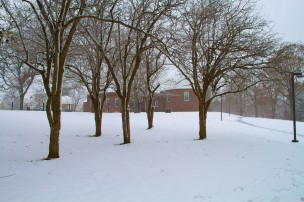In conjunction with Connecticut state officials and the Department of Energy and Environmental Protection (DEEP) Microgrid Pilot Program, the University has installed new energy-efficient systems that will benefit electricity distribution across campus. A microgrid is a localized system of energy production and distribution intended to create a more manageable, effective, and reliable framework for electricity generation. The microgrid should allow the University to better weather storms that might have previously caused power outages.
A grant provided by Connecticut Governor Dannel Malloy’s initiative to improve the versatility and efficacy of electricity statewide made the new work possible; the University was selected to receive a grant out of a pool of 36 applicants. The initiative followed the extensive power outages resulting from Tropical Storm Irene and the October 2011 snowstorm. The pilot program was passed under Malloy’s storm response bill, Public Act 12-148.
“Microgrids play a major role in our efforts to modernize and harden our infrastructure to withstand severe weather,” Malloy said in a press release in July. “These projects will help protect residents and vital public services even when the power goes out, and in doing so allow us to provide critical services during times of emergency.”
Nine microgrid projects, including that of the University, were awarded $18 million in total. Malloy’s DEEP Microgrid Pilot Program was the primary provider of funds. Installments similar to the University’s will take place in Bridgeport, Groton, Storrs, Windham, Fairfield, Hartford, and Woodbridge.
The University’s project involves the expansion of its preexisting electrical microgrid. Director of Physical Plant Alan Rubacha, who is managing the design and construction of many of the microgrid projects along with Director of Utilities Management Peter Staye, explained the microgrid’s function in an email to The Argus.
“At Wesleyan, we distribute electrical power to most of our core campus buildings, essentially all campus buildings with the exception of wood frame houses,” Rubacha wrote. “Our microgrid originates from equipment located at the Vine Street parking lot.”
According to Rubacha, the Vine Street equipment receives the majority of electrical power from two primary feeders at 13,200 volts, which is then distributed to other buildings on campus through a network of cables, switches, transformers, manholes, and duct banks.
“The equipment at Vine Street can automatically transfer from one feeder to the other in the event of a utility feeder failure,” Rubacha wrote. “We also generate about 80% of our electricity at the central power plant using a 2.4 [megawatt] congregation system and that electricity is fed into the campus loop from a feeder and switch nearby the plant.”
The new microgrid installations have created a significantly more dependable energy dispersal system than the University’s previous one, according to Rubacha.
“We have a more robust and reliable electrical distribution system [now] than if each building were fed from the utility, and we have the capacity to feed much more of the campus using our cogeneration equipment in the event of a long term utility outage,” Rubacha wrote.
If the campus experiences expansive power outages in the future, the University’s local microgrid system will be able to provide a stable back-up system for electricity. Dat Vu ’15 recalled his experience during the 2011 blackout and expressed his excitement for the microgrid’s potential.
“The microgrid is a good solution to our school’s electricity distribution–especially in emergency situations when the power goes out,” Vu said. “I remember how crowded the Nics and Usdan were during the huge snowstorm two years ago, and I had to take freezing cold showers in the Butts because our power was out.”
The enhancements to Wesleyan’s microgrid also include the expansion of cogeneration capacity at the Freeman Athletic Center.
“We installed a duct bank, cables, and new switching to bring Freeman Athletic Center onto our Vine Street distribution system,” Rubacha wrote.
With the support of three electrical vaults, four switches, and thousands of feet of conduit cables, the duct bank stretches from the tennis courts, up Knowles Avenue, and under Cross Street, connecting the Freeman Athletic Center system to the Vine Street system.
“Freeman will benefit from the existing cogeneration system, and Freeman will now offer a good place for additional cogeneration that can be easily fed back to the campus grid,” Rubacha wrote. “This will improve safety and business continuity throughout campus.”
According to Governor Malloy’s press release, he has recommended an additional $30 million in funding for Connecticut’s microgrid program for the next two years. There will be additional rounds of funding for projects in the future.
“Under Governor Malloy, Connecticut has become a national leader on energy policy—and our microgrid program is another example of that,” DEEP Commissioner Daniel C. Esty said in Malloy’s July press release. “By employing microgrids, we will improve public safety and reduce the inconvenience for our residents when any future power outages occur. As we move forward with future rounds of funding, we will continue to shape the program to best fit the needs of Connecticut communities.”
Rubacha envisions the microgrid program vastly expanding as more people see the potential advantages of the system.
“As more institutions, businesses, and municipalities learn that a robust electrical microgrid system can reduce the impact of a major outage from a storm event like a hurricane or major snow storm while at the same time potentially saving money by producing electricity for their own use, I see the program growing,” Rubacha wrote.

Comments are closed